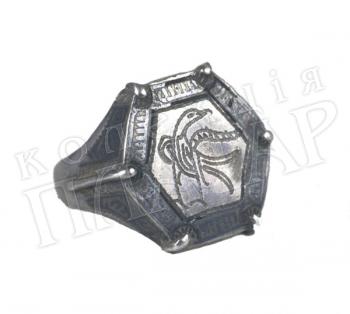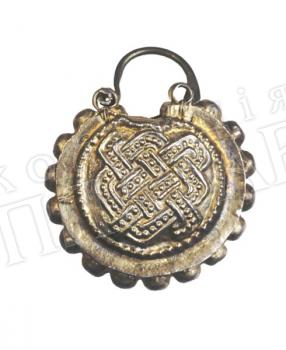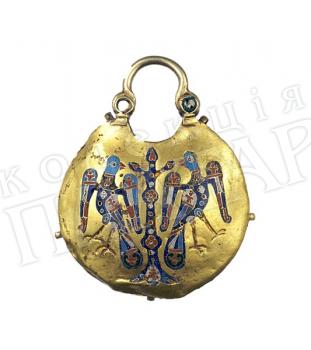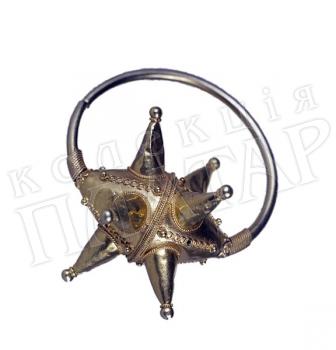Row of beads, which consists of nine of the same types poured of pendants and nine of the same types beads, stamped of silvers plates. Every pendant is made as a quadrangular cross three ends of which are completed with a lily, the fourth end – with two twisted leaves between which there is an ear for hanging. The reverse of pendant is flat. Beads are bitapered identical to the glass prototypes. Every bead is divided into two equal parts by a imprinted circle of rings, and the lengthened petals branch out it. The ninth central bead is similar by the form and ornamenting to the others, however, the petals on it have the through decorative openings.
Byzantine Empire. Kyivan Rus. Nomads
Byzantine Empire was found in IV century A.D.in the time of depression of Roman Empire and was existing till the middle of the XV century. Its artistic culture, which appeared in the break of two epochs – antique and middle ages – absorbed in itself the best achievements of Greek–roman traditions. Geographical location of Byzantium which estates were situated on the two continents – Europe and Asia, caused to the uniting of Asian and European influences affected the citizen life, culture and art of Byzantium. Leadership of Orthodox Church defined the singularity of development of Byzantium artistic culture, spiritual character of its art. Connection with antique traditions, however, was never broken. Especially stable it was in the field of applied art, the role of which didn’t come only to the ornamental or practical functions in the middle ages.
Byzantine civilization had a great influence on the development of the culture of many middle age countries of Eastern and North–Eastern Europe. Adoption of Christianity bound tightly the states of the Balkan Peninsula, Transcaucasia, Caucasia, Kyivan Rus and the Crimea with the center of eastern Christianity — Constantinople church. During the whole period of the existence of Byzantine Empire Constantinople was the legislator of the development of their religious life and artistic culture.
Sights of Byzantine art in the collection of the PLATAR are represented by the cults items of Epichristian and the middle Byzantine art, which resemble, probably, from the Black Sea coast which entered at this time in the complement of the Byzantine Empire. Among them there is such unique items of church utensil, as glass reliquary in the form of little sarcophagus and gold chalice, a cup for which is a glass bowl with the image of cross on the bottom. Prochanski relics are represented by an ampoule for consecrated water or anointing oil, a lamp with the image of martyrs Christenery, bronze crosses-panagias of so-called “Syrian” type and etc. About Byzantium jeweler’s art, which was formed in traditions of Roman capital school, we can judge by gold decorations with the cornelian insertions. Only Christian symbolism and some technological features distinguish them from the similar wares of Roman time.
Expensive gold decorations and other articles of luxury were the important element of Byzantine diplomacy. With their help Byzantium provided “friendship and collaboration” with the neighbouring states. Exactly to such things belong golden kolts with the glass insertions, decorated in a barbarian manner, that usually were found in the burial places of well–to–do Khazars. The wares of local masters (the Black Sea coast) presented by the gold pressed leave–shaped pendants which imitate Byzantine standards.
Since IX century Kyivan Rus — one of the biggest states of the medieval Europe the frontiers of which were stretched out from the Black sea to the Baltic sea and from the Carpathians to the Volga — was the mighty neighbour of Byzantium in the north. Feudal separatism and the Tatar-Mongolian invasion became the reason of short life of this state establishment, however its capital Kiev — up to the defeat in 1240 remained the political, spiritual and church center of all east-Slavic lands.
Jeweler’s art of Kyivan Rus is one of the bright pages of the development of the world art. Golden and silver decorations of X–XIII century in the collection are represented as by separate finds as well as sets of four treasures in composition of which are: temporal rings of the Kiev type, kolts, decorated with niello and enamels, necklace with lily–shaped pendants, finger–rings and bangles. Filigree, granulation and niello were the favorite techniques of Old Russian jewelers–masters. Partitions enamels were the top of Kiev goldsmiths, the technique of making enamels they adopted from Byzantine masters. Originality of form, the systems of decor and maintenance of images make of the Old Russian enamels the decoration of most museums of the world. To the rare standards of this type of art belong gold kolts with the image of peacocks and winged horse on the objects from the treasure of gold decorations.
By the works of jeweller’s art in the collection the represented arts and crafts of nomads of south Russian steppe – the Kipchaks, the Pechenegi, the Torki which threatened constantly to the bounders of Kyivan Rus from the end of IX century up to the Mongolian–Tatar invasion. Soldieries conflicts changed by periods of truce, during which the Old Russian princes, for example, concluded marriages with daughters of the Kipchak khans, sometimes enemies became allies, the robbery changed by the point-of-sale relations. As a result, especially in XII century, the Old Russian decorations, the items of armament and the household goods got to the nomadic steppe.
About the unique originality of jeweler’s art of nomads testify the finds of decorations such typical for them, as large gold “horned” kolts with conical spikes, decorated with granulation and filigree. Also silver temporal rings and earrings with the affected empty bead, which are mainly found in the burial places of men and women; silver decorations of hats, necklace and bangles made of gagate and glass, twisted and the pseudo convoluted hryvnias, analogies of which are known among the Old Russian rarities.














